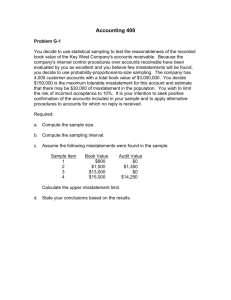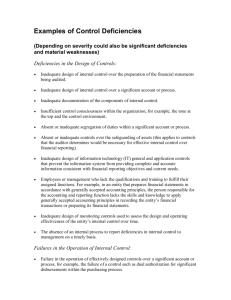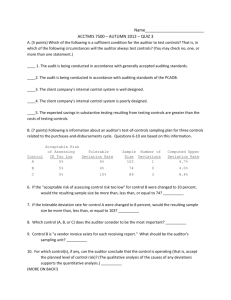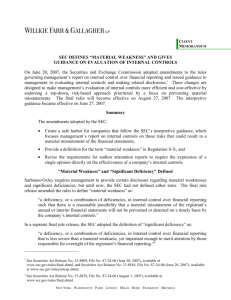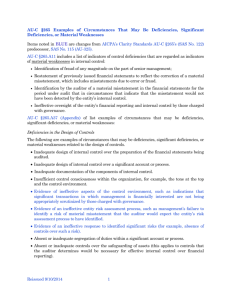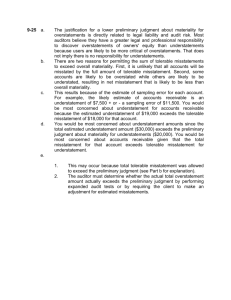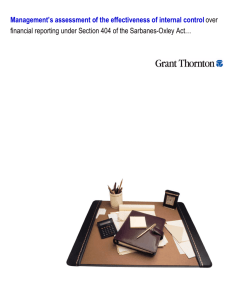GASB Update
advertisement
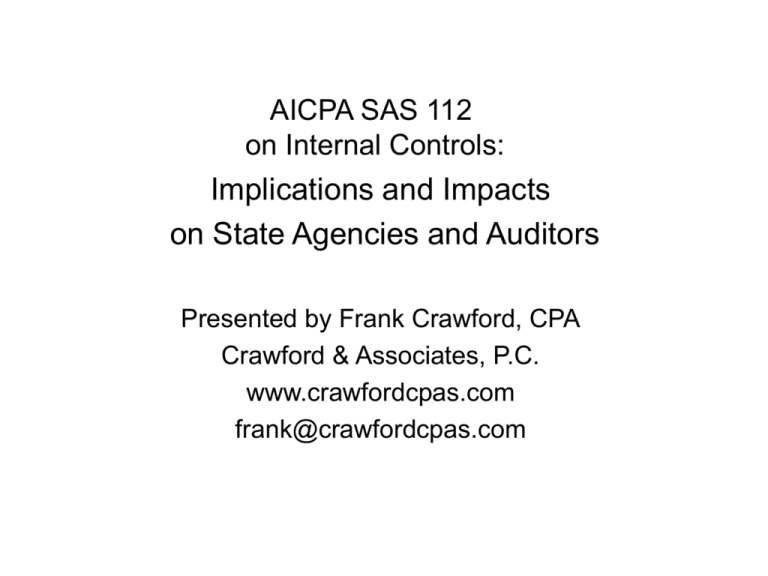
AICPA SAS 112 on Internal Controls: Implications and Impacts on State Agencies and Auditors Presented by Frank Crawford, CPA Crawford & Associates, P.C. www.crawfordcpas.com frank@crawfordcpas.com Auditor’s Responsibilities • In an audit of financial statements under GAAS and GAGAS, the auditor: – is not required to identify deficiencies in internal control – is not required to express an opinion on internal control effectiveness – is required to understand controls in assessing risk of misstatements – is required to test internal controls for effectiveness, if they intend to rely on the controls to reduce audit work • SAS 112 did not change these requirements Slide 2 In a Nutshell, SAS No. 112… • Defines the terms control deficiencies, significant deficiencies and material weaknesses and conforms those definitions to those in PCAOB AS#2 • Provides guidance for auditors on evaluating the severity of control deficiencies • Requires the auditor to communicate, in writing, to management and those charged with governance (Should be communicated even if they were communicated in connection with previous audits and are still applicable) • Effective date = audits of periods ending on or after December 15, 2006 Slide 3 Communication to Whom? • Those charged with governance = the persons with responsibility for overseeing the strategic direction of the entity and the entity’s financial reporting and disclosure process. (May be collective responsibility) • Recognizes that the bodies to whom communication is made may take different forms – Management (or committee thereof) – Agency Board (or committee thereof) – Legislative or governing body (or committee thereof) Slide 4 SAS 60 Classifications REPORTABLE CONDITION NOT MATERIAL WEAKNESS MATERIAL WEAKNESS Slide 5 SAS 112 Classifications CONTROL DEFICIENCY NOT SIGNIFICANT DEFICIENCY NOT CONSIDERED MATERIAL WEAKNESS SIGNIFICANT DEFICIENCY MATERIAL WEAKNESS Slide 6 Control Deficiency OLD DEFINITION NEW DEFINITION Not defined. A control deficiency exists when the design or operation of a control does not allow management or employees, in the course of performing their assigned functions, to prevent or detect misstatements on a timely basis. Slide 7 Control Design and Operation • Deficiency in Design – Necessary control is missing – Control exists but is not properly designed to accomplish control objectives • Deficiency in Operation – Person performing the control is not capable or have sufficient authority to perform the control effectively – Designed control is not being followed as designed Slide 8 Types of Controls • Preventive – Designed to prevent misstatements – Example: Segregation of duties • Detective – Designed to detect and correct misstatements – Example: Independent reconciliation of accounts Slide 9 Internal Control Components • Control deficiencies may involve one or more of the five interrelated components of internal control (SAS 55) – Control environment – Risk assessment – Control activities – Information and communication – Monitoring Slide 10 Control Environment • Integrity and ethical values stressed • Effective board oversight • Management’s philosophy/style and organizational structure supports effective internal controls • Accounting and financial reporting competencies of management and staff • Authority and responsibility over internal controls assigned Slide 11 Risk Assessment • Clear financial reporting objectives established • Risks identified that could adversely affect achievement of objectives – Risk of errors – Risk of fraud Slide 12 Control Activities • Well-documented policies and procedures related to accounting and financial reporting • Effective segregation of duties • Effective review and reconciliation • Effective information technology controls Slide 13 Information and Communication • Necessary financial information to achieve financial reporting objectives is maintained by sufficiently capable information systems • Information needed to implement other control components is captured and communicated Slide 14 Monitoring • Internal audit or monitoring of internal control effectiveness • Control deficiencies are timely communicated • Corrective action plans are developed and monitored for implementation Slide 15 Significant Deficiency OLD DEFINITION NEW DEFINITION A reportable condition involves a matter coming to the auditors attention relating to significant deficiencies in the design or operation of the internal control that, in the auditor’s judgment, could adversely affect the organization’s ability to initiate, record, process, and report financial data consistent with the assertions of management in the financial statements. A significant deficiency is a control deficiency, or combination of control deficiencies, that adversely affects the entity’s ability to initiate, authorize, record, process, or report financial data reliably in accordance with GAAP or OCBOA, such that there is more than a remote likelihood that a misstatement of the entity’s financial statements that is more than inconsequential will not be prevented or detected. Slide 16 Misstatement • A misstatement causes the financial statements not to be fairly stated in conformity with GAAP • Misstatement may consist of: – A difference in the amount, classification, or presentation of a financial statement element, account or item as required by GAAP – The omission of a financial statement element, account or item – Omitted disclosures or non-GAAP disclosures Slide 17 Misstatement (Cont.) • Misstatements may be of two types: – Known – specifically identified • Unaccrued invoices for goods or services received • Unrecorded cash transaction – Likely – extrapolation of sample results or unreasonable estimates • Depreciation, allowances for uncollectible receivables, self-insurance obligations Slide 18 Remote Likelihood • Remote likelihood has the same meaning as in FASB Statement No. 5 – Probable – the future event is likely to occur – Reasonably possible – the chance of the future event occurring is more than remote but less than likely – Remote – the chance of the future event occurring is slight • Therefore, the likelihood of an event is “more than remote” when it is reasonably possible or probable Slide 19 More Than Inconsequential • More than inconsequential describes the magnitude of potential misstatement that could occur as a result of a significant deficiency • Misstatement is “inconsequential” if a reasonable person would conclude would clearly be immaterial to the financial statements • In determining whether potential misstatement would be more than inconsequential, auditor should consider qualitative and quantitative factors • A potential misstatement may be inconsequential quantitatively, but may still be considered more than inconsequential due to qualitative factors Slide 20 Quantitative Factors • Interpretation No. 3 – Quantitative Measures of Materiality in Evaluating Audit Findings, to SAS 47 - Audit Risk and Materiality in Conducting an Audit • Matter of auditor’s professional judgment • Overall financial statement material is based on a percentage or dollar amount related to an element or elements in the financial statements for “each opinion unit” that are expected to affect the judgment of a reasonable person relying on and using the statements (generally considered 0.5% - 5.0% of opinion unit base) • In government entities, total assets, total revenues, or fund balance/net assets are often important and widelyused elements or bases • SAS 112, paragraph 8, uses 20% of overall financial statement materiality to define clearly immaterial (inconsequential) Slide 21 Qualitative Factors • Interpretation No. 4 – Considering the Qualitative Characteristics of Misstatements, to SAS 47 - Audit Risk and Materiality in Conducting an Audit • Matter of auditor’s professional judgment influenced by the auditor’s perception of the needs of a reasonable person using the statements • Qualitative factors for consideration include: – A misstatement that turns a net loss into net income – A misstatement in turns a negative unrestricted net assets to a positive amount – A misclassification that turns a negative budget variance into a positive variance Slide 22 Qualitative Factors (Cont.) • Qualitative factors for consideration include: – Potential effect of misstatement on compliance with debt covenants or important regulatory requirements – Misstatement that rewards management for performance (bonus, job retention, political promise) – Misstatement that would result in avoiding a single audit when required – Sensitivity of circumstances surrounding the misstatement, such as fraud, abuse, etc. – A misstatement that has implications on motivations or integrity of management – The risk of additional undetected misstatements Slide 23 Material Weakness OLD DEFINITION NEW DEFINITION A material weakness is a reportable condition in which the design or operation of one or more of the internal control components does not reduce to a relatively low level the risk that misstatements caused by error or fraud in amounts that would be material in relation to the financial statements being audited may occur and not be detected within a timely period by employees in the normal course of performing their assigned functions. A material weakness is a significant deficiency, or combination of significant deficiencies, that results in more than a remote likelihood that a material misstatement of the financial statements will not be prevented or detected. Slide 24 Example of Magnitude • Assumptions – Opinion unit planning and reporting materiality is $100,000 – Likelihood of misstatement is more than remote – No compensating controls exist to mitigate control deficiency Slide 25 Example of Magnitude (cont) • Inconsequential = potential misstatements from control deficiency, or combination thereof, is quantitatively less than $20,000 (20% of $100,000), AND is not qualitatively material • More than inconsequential = potential misstatements from control deficiency, or combination thereof, is quantitatively more than $20,000 (20% of $100,000) but less than $100,000, AND is not qualitatively material • Material weakness = potential misstatements from control deficiency, or combination thereof, is quantitatively $100,000 or more, OR is qualitatively material Slide 26 Evaluating Deficiencies • Evaluation of “identified” control deficiencies as to severity, whether individually or collectively they are – Significant deficiencies – Material weaknesses • Severity of control deficiencies – Based on likelihood and magnitude of misstatements – Depends on the “potential” for misstatement, not whether an actual misstatement has occurred Slide 27 Evaluating Deficiencies • Examples of factors that may affect the likelihood that a control could fail to prevent or detect a misstatement – Susceptibility to loss or fraud – Subjectivity and complexity of the amount involved – Cause and frequency of any known or detected exceptions related to the operating effectiveness of a control • Examples of factors that may affect the magnitude of a misstatement that could result from a deficiency – Financial statement amounts or total of transactions exposed to the deficiency – Volume of activity in the account balance or class of transactions exposed to the deficiency Slide 28 Evaluating Deficiencies • Auditor should also evaluate possible mitigating effects of effective “compensating controls” • A compensating control limits the severity of the control deficiency (i.e. keeping it from reaching a significant deficiency or material weakness) • Compensating controls can mitigate the effects of a control deficiency, but do not eliminate the deficiency • To consider compensating controls in their evaluation, auditors must test the controls for effectiveness Slide 29 Compensating Controls • Preventive Control Deficiency – Lack of segregation of duties over payables and disbursements • Compensating Detective Control – Executive level review of all disbursements made in excess of $1,000 in books and bank statements Slide 30 Written Communication • Written communication required no later than 60 days following issuance of audit report (including deficiencies that were communicated in previous audits) • Auditor may decide communicate certain deficiencies during the audit • SAS 112 includes an appendix containing examples of circumstances that may be control deficiencies, significant deficiencies, or material weaknesses Slide 31 Management Letter • Also states that nothing precludes the auditor from communicating to management and those charged with governance other matters that the auditor: – Believes to be of potential benefit to the entity – Has been requested to communicate • Such a communication can be done orally or in writing Slide 32 Management’s Responses • Management may wish to, or be required to, prepare a written response to the auditor’s communication • Such response may include: – a description of corrective actions, – the entity’s plans to implement new controls, or – a statement indicating that the cost of correcting would exceed the benefit • If such a response is included in a document with the auditor’s written communication the auditor should add a paragraph to the communication disclaiming an opinion on such information Slide 33 Is a Control Deficiency a Significant Deficiency? • Answer the questions: – Is the likelihood that a misstatement of any magnitude could occur and not be detected by the client’s controls considered remote? – Is the magnitude of a potential misstatement inconsequential or less than inconsequential to the FS? – Are there complementary or redundant controls that were tested and evaluated that achieve the same control objective? – Are there compensating controls that were tested and evaluated that limit the magnitude of a misstatement of the FS to inconsequential? Slide 34 Is a Significant Deficiency a Material Weakness? • Answer the questions: – Is the magnitude of the potential misstatement less than material to the financial statements? – Are there compensating controls that were tested and evaluated that limit the magnitude of a misstatement of the FS to less than material but more than inconsequential? – Does additional evaluation result in a judgment that the likelihood of a material misstatement of the financial statements is remote? Slide 35 Questions??? Slide 36
